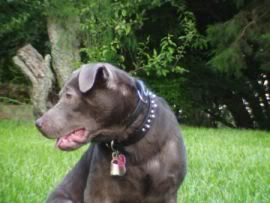Hi Margaret. Personally I would put the ecollar away for a while and put more effort into the marker training. I'm not real big on the different terminology but I think sometimes when you spend too much time with corrections and trying to restrict and stop things that it almost acts like giving the dog a release to go nuts when your not enforcing with the collar. They don't really know what you want and are only trying to avoid punishment. And I would also say use two crates and work them one at a time.
Vital points here.
I would shift my mind-set to teaching what I do want instead of concentrating on what I don't.
And Lynne's suggestions will help you a lot too.
Marker training: This is fun for both dog and handler, doesn't trigger fear, confusion, and anxiety in a dog who is not sure when and why the hammer will fall, and is easy for multiple handlers to help with.
Personally, I would consider crates to be absolutely necessary in a two-dog house, and when they are rambunctious -- double necessary.

I have multiple dogs, as have many on this board. So I am speaking from long experience.
I would have short drag lines on both indoors. I know from your PM that terminology here is challenging, so a drag line is nothing more than a little leash with no handle-loop to catch on things in the house. This gives you far better control in an excitement situation (which you want to avoid, but they do happen). You can cut off the loops on old fabric leashes or (what I do) use a piece of an old cotton long-line.
http://leerburg.com/729.htm
BTW, that line is worth its weight in gold. I use a new one for training the recall to a dog who has had bad training (and who has learned to play keep-away or to ignore the recall unless he feels like complying). My old ones are kept around the house and yard for a temporary tie-out (
temporary!, such as when I work with one dog and I want the others to keep their grubby lil noses out of our food rewards), and as I mentioned, one is cut up for drag lines.
I have actually washed them in the washing machine, too, inside a pillowcase along with a towel to keep the buckle from whacking the washer tub, then dried by hanging on its hook by the door.
Now. Start teaching them, one at a time, how they act when the doorbell rings or someone comes in. Get a helper to be the visitor. Grab a bunch of very high-value treats (cooked bits of meat or bits of cheese are great) and teach sit or whatever you want them to do with the door cue. Make the behavior some feet from the door, too. Practice, in short upbeat sessions. Reward generously.
I would add never never never react to excited behavior with excited behavior. No matter what the human is saying (or meaning), this is nothing but escalation of the bouncing/barking/jumping.
I would start with the Pack Structure video and the Basic Ob video. I would do short and upbeat marker sessions throughout every day. I would really work on making training a wonderfully fun thing in their day. Here is what happens with marker training: The dog hears you say "Let's train" or whatever (I just call my dogs' names and they come a-runnin' like freight trains, ears flying, hoping beyond hope that a training session is in the works) and the dog is thrilled!
I would encourage everyone in the family NOT to reward excited behavior with fuel, but to stand like a statue (back to them if they are jumping/bouncing) and give zero attention. The instant there is quiet, I'd mark and reward.
I'd have them in the crate when your husband is due home (exercised and with the edge off) and would not look at them until there was quiet, at which point I would mark, praise, and open the door. I would NEVER open the door for a barking bouncing dog.
On walks, I would have one on each side. I find this easier than two in one hand. I'd wear a bait bag
http://leerburg.com/736.htm so I could incorporate little marker sessions in the walk. It's good for your keys, etc., too.
I think that the major challenge here is that they have learned that they can trigger excitement and attention with bad behavior. If good behavior is marked and rewarded, that will be the behavior they will learn to do. They want attention and rewards, and it's up to you what they get them for!
Please post back, because this message is getting long. But it's a start.

P.S. They're not ready for the e-collar. JMO. I would want to do a
lot more foundation work for now.
 Previous Topic
Previous Topic Index
Index Next Topic
Next Topic











 Top
Top




 If one behavior produces no rewards, well, then, they will use the one that does! But you must be absolutely consistent. Rewarding a prolonged bouncing session with attention merely ups the ante, and they have learned that the more they prolong bad behavior, the more likely it will "work."
If one behavior produces no rewards, well, then, they will use the one that does! But you must be absolutely consistent. Rewarding a prolonged bouncing session with attention merely ups the ante, and they have learned that the more they prolong bad behavior, the more likely it will "work." 


